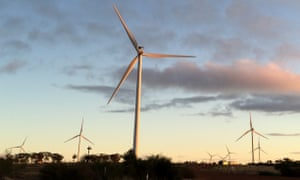$1bn project in Queensland’s Bowen basin to consist of almost 200 turbines
The Queensland
government has approved the country’s largest windfarm, a $1bn project
to build almost 200 turbines in the shadow of the Bowen basin’s
coalmines.
The 800-megawatt Clarke Creek project, in cattle country north-west of Rockhampton, received planning approval on Tuesday morning. The company behind the project, Lacour Energy, says it will create about 350 jobs during three years of construction and has the capacity to provide 3% of the generation required to power the entire state. It also includes a solar component.
The announcement today comes amid increasing land-use conflicts, as agricultural land is repurposed by the state’s fast-expanding renewables industry.
The Clarke Creek wind and solar farm extends across the land of eight local families, with the turbines to be built on higher ground. It’s understood that the project did not require an impact assessment because of the relatively small population in the surrounding area, and was instead code assessed.
A local reference group has no objection to the project in its completed state, but Guardian Australia understands locals do have concerns about the construction phase, in particular the disruption that will be caused as massive turbines are brought from the port at Gladstone through winding country backroads. During construction, there will be more workers at the project than residents of the Valkyrie area, which encompasses Clarke Creek.
Lacour Energy says construction should begin next year. “It is a unique renewable energy project which combines excellent wind and solar resources at a location directly adjacent to the backbone of the ... transmission network,” said its director, Mark Rayner.
“The windfarm development approval is a significant milestone for the project.”
The Queensland government plans to reach 50% renewable energy generation by 2030. The energy minister, Anthony Lynham, said $20bn in energy projects were in the pipeline, with projects worth $4.5bn already under way or with finance committed.
“Lacour Energy has worked closely with the department to assess acoustic impacts of the windfarm as well as impacts on fauna and vegetation,” Lynham said.
The 800-megawatt Clarke Creek project, in cattle country north-west of Rockhampton, received planning approval on Tuesday morning. The company behind the project, Lacour Energy, says it will create about 350 jobs during three years of construction and has the capacity to provide 3% of the generation required to power the entire state. It also includes a solar component.
The announcement today comes amid increasing land-use conflicts, as agricultural land is repurposed by the state’s fast-expanding renewables industry.
The Clarke Creek wind and solar farm extends across the land of eight local families, with the turbines to be built on higher ground. It’s understood that the project did not require an impact assessment because of the relatively small population in the surrounding area, and was instead code assessed.
A local reference group has no objection to the project in its completed state, but Guardian Australia understands locals do have concerns about the construction phase, in particular the disruption that will be caused as massive turbines are brought from the port at Gladstone through winding country backroads. During construction, there will be more workers at the project than residents of the Valkyrie area, which encompasses Clarke Creek.
Lacour Energy says construction should begin next year. “It is a unique renewable energy project which combines excellent wind and solar resources at a location directly adjacent to the backbone of the ... transmission network,” said its director, Mark Rayner.
“The windfarm development approval is a significant milestone for the project.”
The Queensland government plans to reach 50% renewable energy generation by 2030. The energy minister, Anthony Lynham, said $20bn in energy projects were in the pipeline, with projects worth $4.5bn already under way or with finance committed.
“Lacour Energy has worked closely with the department to assess acoustic impacts of the windfarm as well as impacts on fauna and vegetation,” Lynham said.

No comments:
Post a Comment